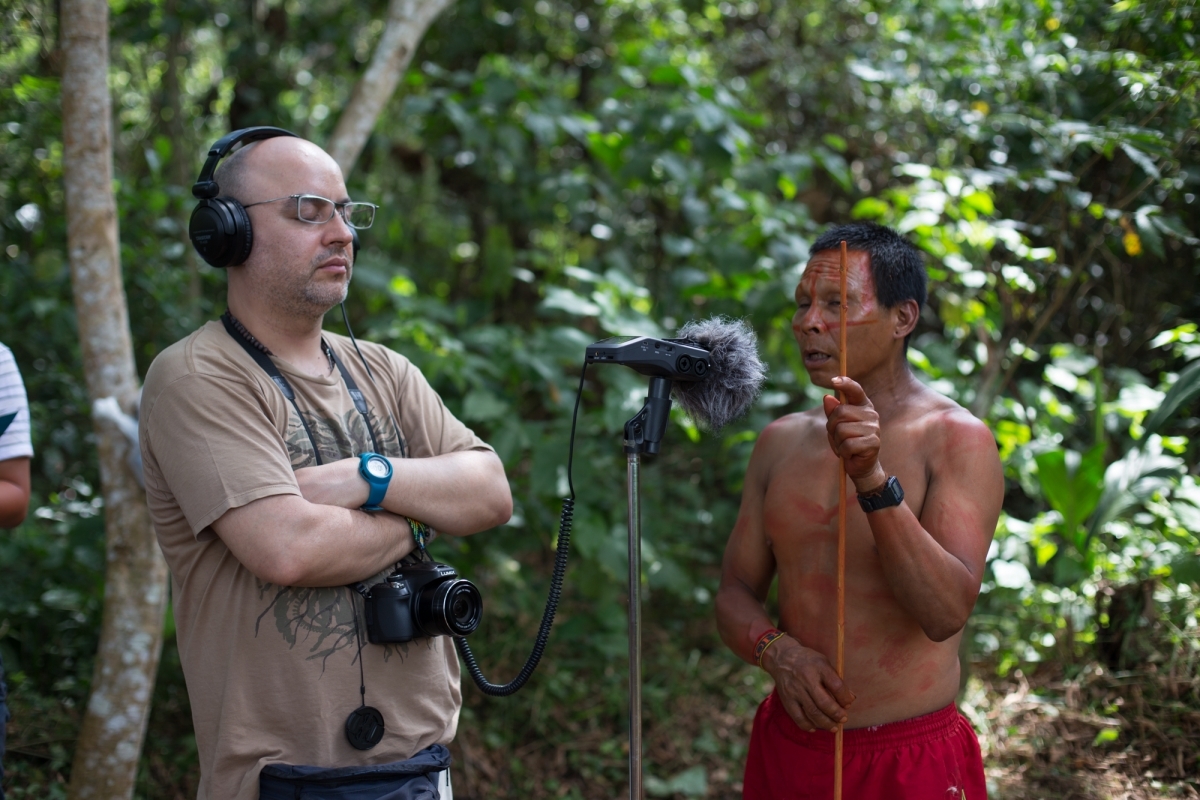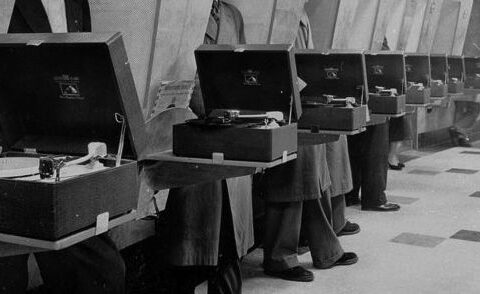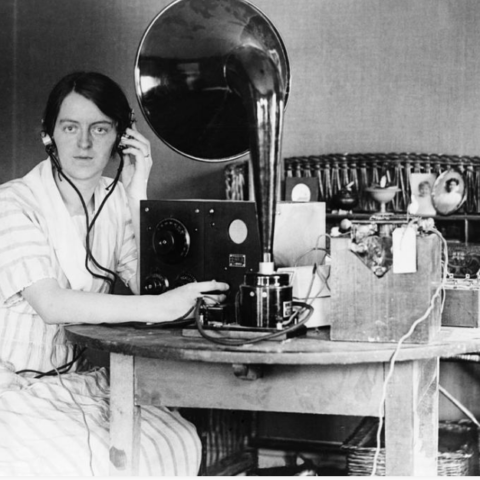León David Cobo is a Colombian artist who works with sound, community field work, and listening, and has a practice operating somewhere between sound art, ethnomusicology, anthropology and ethnography. His work with vulnerable communities who have been exposed to violence and armed conflict makes him a key reference, considering the ethical and affectionate aspects of the practice. To examine his work, I interviewed him in June 2020 and this section presents my notes from this dialogue, and some reflections on my part at the end.[1]
Most of his work is exhibited in museums as multichannel and binaural pieces of original untreated recordings based on oral tradition and ceremonial music, rarely displaying visual elements although he collaborates with illustrators and photographers; but he explicitly avoids the representation of the moving image on video in his expositions. Cobo told me that his work with non-treated long duration recordings is, in part, a consequence of his presence in these communities already being intrusive enough, so he prefers to approach his work as a bridge between these individuals and the listener, attempting to diffuse himself to become a better medium so that the Other can resonate.*
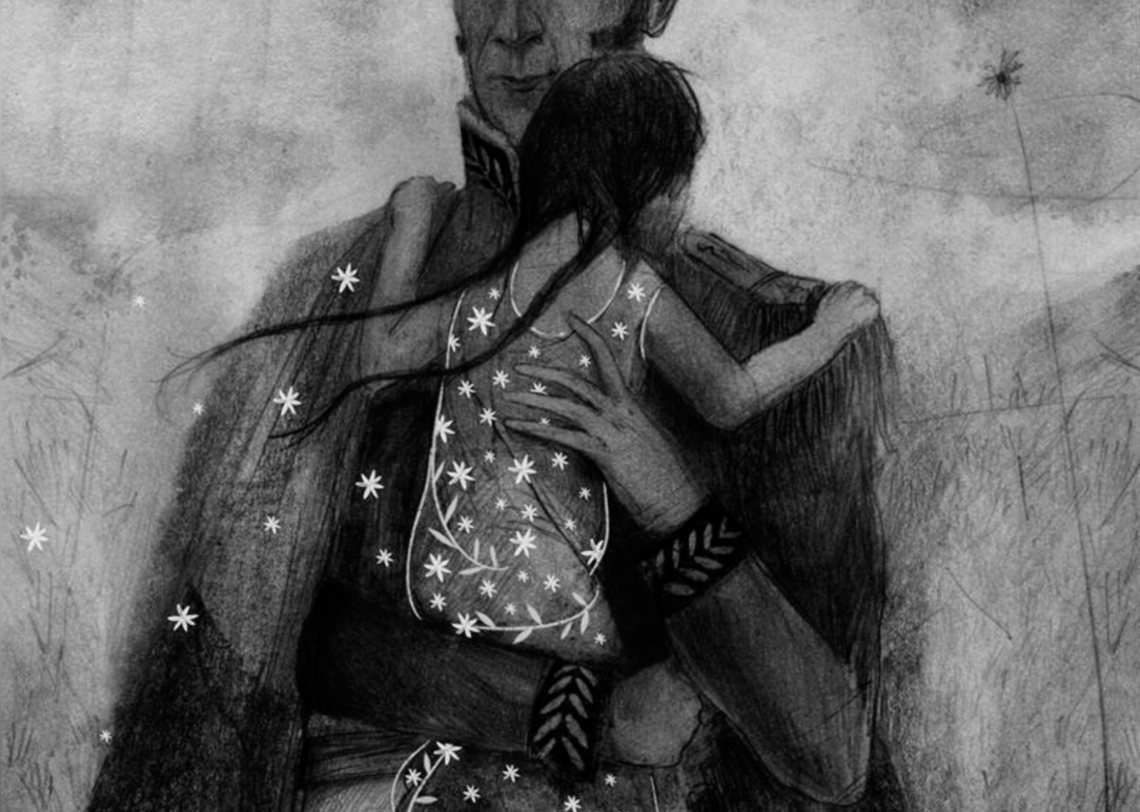 Illustration: Geison Castañeda Perico.
Illustration: Geison Castañeda Perico.
Mujeres Olvidadas del Bicentenario (Forgotten women of the bicentenary)[2] is a collaborative multimedia installation founded on oral tradition recordings, illustrations and text which was created by León David Cobo and the Micrófonos En Libertad collective. The aim was to give a voice to the many revolutionary women who courageously helped Colombia gain independence from Spain but who were granted little or no recognition due to gender biases minimizing the historic relevance of their actions. In my work with field recordings and environmental sounds, the questions about where to focus the ears and the microphone is a political question about the poetic and philosophical in sound art and in reference to León’s work in Forgotten Women of the Bicentenary. I was interested in these stories, which are narrated by women who are related to the long-forgotten female emancipators.
In this regard, Cobo says that he is captivated by otherness, bearing in mind that Colombia is a country with many voices, which often are antagonistic to one another, but also where others are muted or unheard. For Cobo these dramatic differences are one of the reasons why Colombia has been immersed in an armed conflict for so many decades. The possibility of listening to otherness was central in his interest in the stories of these dauntless unsung heroines, as well as his preceding concern with violence and discrimination against women in Colombia, a problem that he has examined in a series of sound projects. In Mujeres Olvidadas del Bicentenario, he and the collective Micrófonos en Libertad engaged in stories of great historical and poetic significance about champions like Matilde Anaray, Juana Escobar and Cleotilde Escobar de Niño. In the production of this project, Cobo encountered a series of circumstances that put the spotlight on the political, social, and cultural tensions pervading Colombian territory in the form of armed conflict, which he perceives as a cross-cutting element in all of his field work with communities in Colombia.**
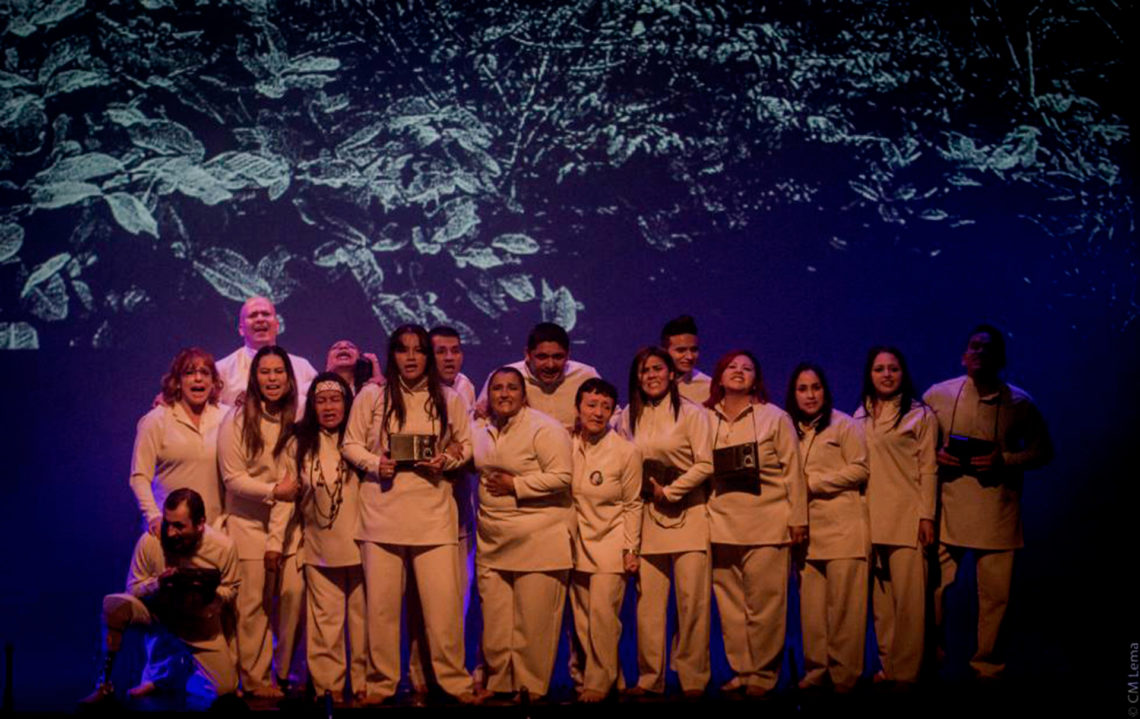
Photo from Victus (Courtesy: Casa Casa E Borrero)
Cobo has been conducting field work with communities since 1999, and in these years he has conversed and collaborated with acts of armed conflict as was illustrated in Victus [3], a performing collective project of which he was part. Here, adversaries in the Colombian conflict, such as former guerrilla, paramilitary, and public forces, together with civilians (víctimas civiles), shared the stage to perform a piece that aimed to give a voice to the different actants in the conflict. In this regard, I asked him about the methodologies that were followed in this complex and sensitive process.
In Victus Cobo says, it was extremely important to work with a pedagogist like María Victoria Estrada and adhere to the theories of Humberto Maturana, in order to avoid romanticizations and biased, polarizing criticism; otherwise, it could have affected any possibility of dialogue between the parties. The methodology used in this process took into consideration ideas such as Maturana’s biology of love [4] and autopoiesis (circularity) [5] where it is important to approach the other as an equal. With the aim of understanding the nature of Colombian conflict, the Victus group developed a timeline to trace back the history of violence in the country, almost back to the Big Bang, and this reflection spurred them to invite a group of physicists to help them study the forces and laws of the universe where they could connect chaos theory with the armed conflict in Colombia. This provided them with a philosophical and poetic understanding to such complex and sinister phenomenon. Here, Cobo says, the performers acknowledged their war experiences as precarious and miserable, leading to arid, broken territories, hence the need to create new experiences for ex- combatants and civilians (víctimas civiles) by means of art, where former opponents accepted an invitation to reflect and dialogue together. The neutrality exhibited by Cobo and the other artists involved was key in creating scenarios of exchange and remediation. To be able to achieve neutrality, Cobo says, he needed to self-examine, putting aside the layers of biases, the product of one’s ideology and values, and the stereotypes that one creates, in order to converse with former guerrilla, paramilitary and public forces who committed atrocious crimes. This dialogue occurred following a methodology that he describes as phenomenological, and which generated paths of affection, compassion, and empathy within the group. Cobo believes that the creative process of art, when approached responsibly and ethically, is essential in these processes of affection, dialogue, and remediation among antagonists. Everyone involved should be able to communicate their story and experience to nourish and engage all the parties involved, and this, eventually, will shed light on how to approach and eventually stop the armed conflict, which, after centuries, still claims many lives in Colombia.

Photo from Victus (Courtesy: Casa E Borrero)
Also, for Cobo it was important to listen to the humanity in everyone involved in this conflict and learn about the events and circumstances, such as indoctrinations and forced recruitments, to which they might have been subjected. He cites stories of 9-year-old children being kidnapped to be trained and enlisted in combat groups, which has been a common practice in Colombia for decades. After, and despite being in contact with such brutal and traumatic accounts, Cobo is positive about humanity and believes in the possibility of a solidary and affective society, given an auspicious and loving context. He connects these thoughts with the fact that in the creation of Victus, the identity of the ex-combatants was initially not revealed, but by the time the issue inevitably came up, the potentially conflicting parties were already friends thanks to the artistic affectionate and positive process which occurred.***
In the conversation with Cobo, I recognize the importance of the act of listening in these sensitive and delicate artistic processes in which alterity, affection and solidarity are crucial, so I asked him about the extent to which these experiences of dialogue and remediation privilege the possibility of the sonic subverting problematic elements of the visual discourse.

L.D. Cobo working with the Bora indigenous community in amazonas, Colombia (Courtesy of Francisco Contreras)
For him, biological configurations related with the early development of listening in the womb (16 weeks) are influential considerations in his obstinacy to believe in the artistic practice with sound and its possibility to analyse, understand and heal the relations that we establish with ourselves and our environment. Cobo mentions that he had the privilege to record songs of the Wiwa indigenous community in the Colombian Caribbean, with a ‘wise woman’ singing to the child in the womb to connect the child with the outside world, demonstrating the importance of listening in the spirituality and cosmogony of these cultures. He has also had the opportunity to work with children in different contexts for a number of projects, and this experience has revealed to him the significance of listening during cognitive development and the capacity to create tools for critical analysis in these children. This is another reason for his specific interest in sound pieces based on the affectionate action of listening. Cobo expresses that the suggestive and evocative possibilities of attentive, curious listening are essential in nightly indigenous rituals which gravitate around sound and in which the participants can only imagine and envision these worlds by means of sound.
The artistic decision to tackle the field and the environment in its political complexity holds many implications revolving around the affectionate, the ethical, and the poetics of sound art. When artists conceive no other way to work, they face the possibility of giving resonance to desired worlds in which the potency of life to love overcomes and prevails over struggle and violence. The work and reflections of Cobo help me fathom the scope of the practice with sound in which artists listen and record the life of others doing what they do every day, speaking about their affections and disaffections. It is essential that artists view themselves as catalysers, as mediums that need to be emptied of biases and stereotypes, being able to critique with affection and generosity, joining forces with others and aiding in making desires resonate.
To learn more about the work of L.D. Cobo, visit his website at:
Acknowledgements from León David Cobo
*This body of work has been created as part of individuals projects like
De agua viento y verdor Volumes I, II, III
- 3 x audiobooks
- 1x website
Paisajes sonoros, cantos y relatos indígenas para niños y niñas, de 21 comunidades
- 21 x CD
Funded by Instituto Colombiano de Bienestar Familiar (ICBF), Ministerio de Cultura de Colombia, Plan internacional y Fundalectura 2013-2019. Also: residencia artística de Idartes CKWEB y museo de arte moderno la tertulia en ancestralidad y arte sonoro con el proyecto Mjuese´j (escuchar) developed with the Nasa community in the resguardo triunfo Cristal Páez in Florid Valle del cauca presented in Cali and Bogotá in 2019. The documental series Expedición sonora produced by Unimedios Televisión and funded by Radio Televisión de Colombia (Rtvc) 2004-2007.
**Mujeres Olvidadas del Bicentenario was funded with a grand from the Ministerio de Cultura and the Universidad de los Andes, developed for the collective Micrófonos en Libertad from which is part. Exhibited in the Museo de la Independencia Casa Del Florero (2019-20)
***This project was created as part of the artistic laboratory VICTUS developed with the laboratory of reconciliation: VICTUS, developed with ex-combatants of the FARC and ELN guerrillas, ex-paramilitaries, retired soldiers and victims of the armed conflict in Colombia. Directed by Alejandra Borrero at Casa E Borrero with the support of IOM, USAID and Ministry of Culture (2016-22).
[1] Cobo, L.D. (2020) Interview by David Vélez. Personal Archive.
[2] Cobo, L.D., Micrófonos en libertad (2019) Mujeres Olvidadas del Bicentenario.
[3] VA (2018) Victus. Casa Ensamble.
[4] Verden-Zöller, G., Maturana, H. (2008) The Origin of Humanness in the Biology of Love. Imprint Academic.
[5] Maturana, H., Varela, F. (1972) De Maquinas y Seres Vivos. Editorial Universitaria, S.A.
Header image: L.D. Cobo working with a indigenous Nukak community in Guaviare, Colombia(Author: Francisco Contreras)

